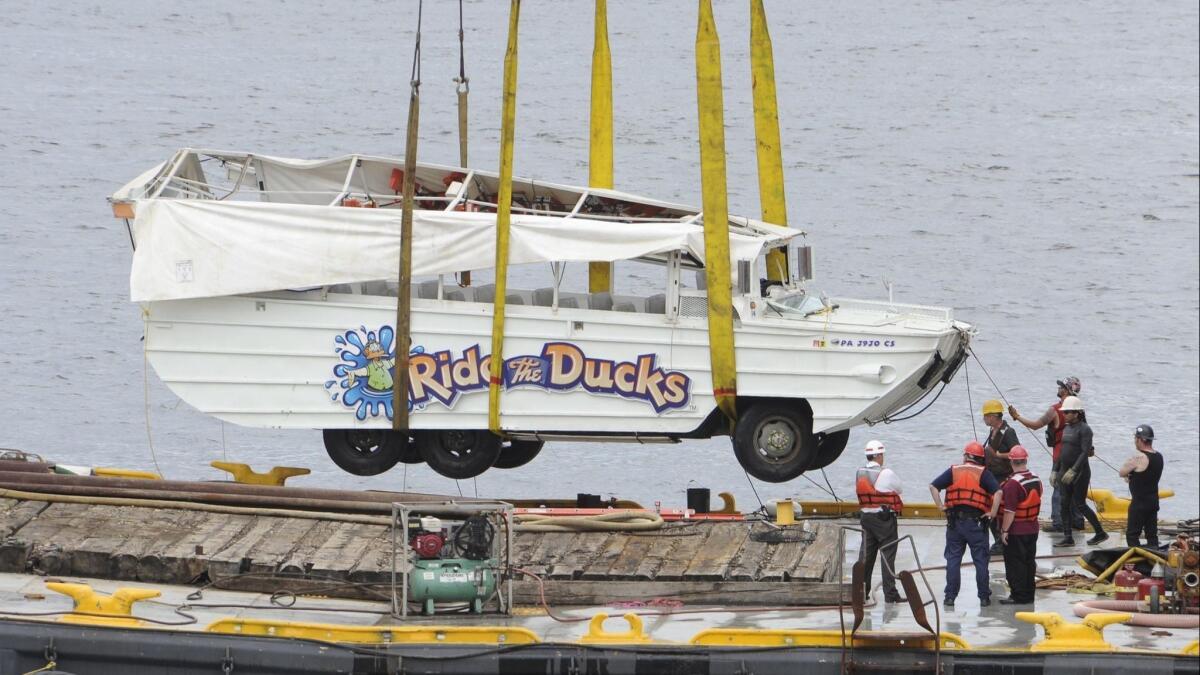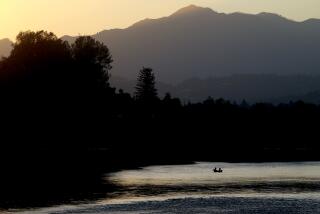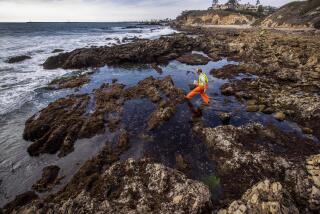Court records show duck boat in Missouri disaster was designed by entrepreneur with no engineering training

A duck boat that sank in southern Missouri, killing 17 people aboard, has been raised.
The duck boat that sank in a Missouri lake last week, killing 17 people, was built based on a design by a self-taught entrepreneur who had no engineering training, according to court records reviewed by the Los Angeles Times.
The designer, entrepreneur Robert McDowell, completed only two years of college and had no background, training or certification in mechanics when he came up with the design for “stretch” duck boats more than two decades ago, according to a lawsuit filed over a roadway disaster in Seattle involving a similar duck boat in 2015.
Officials have not given an official cause for why Stretch Duck 7, the amphibious boat owned by Ride the Ducks, sank during a storm on Table Rock Lake near Branson, Mo., while carrying 31 people on a sightseeing tour.
The Seattle lawsuit did not directly tie McDowell’s design credentials to duck boat tragedies that occurred on water, but in recent days, safety experts, lawyers and U.S. Sen. Claire McCaskill (D-Mo.) have raised concerns about the design and oversight of duck boats, a popular watercraft for sightseers that also has wheels and can drive on land.
“There are inherent dangers in these amphibious vehicles,” McCaskill said on the floor of the U.S. Senate on Tuesday, alluding to a 1999 disaster in Arkansas that left 13 people dead when a duck boat sank rapidly. “When they’re in the water, it’s almost like an enclosed bus.”
In the water, duck boats are like a “sinking coffin” when they start to flood, said McCaskill, who plans to draft legislation proposing stronger safety standards for duck boats.
McDowell and Ripley Entertainment — which bought Ride the Ducks last year — did not respond to messages seeking comment Tuesday. McDowell’s lack of training in engineering was first reported by DCReport.
DUKW boats, as they were originally known in the U.S. military, were created during World War II to transport troops on land and sea. They were afterward sold into surplus and repurposed as pleasure craft by tour companies across the United States that have sometimes created their own versions.
Since then, duck boats have been involved in multiple deadly incidents on roadways and on the water over the last two decades, and multiple lawsuits and federal inquiries have charged that the boats’ designs contributed to the tragedies, according to a Times review of past duck boat incidents.
A National Transportation Safety Board investigation into the 1999 Arkansas disaster, said that the duck boats lacked sufficient buoyancy and that the canopy over the seating area had trapped passengers inside. Some duck boats are open air, while others have transparent coverings on their sides.
A U.S. Coast Guard investigation concurred, warning that enclosed duck boats presented a basic safety problem involving life preservers: If passengers put on life preservers while inside a sinking duck boat, they might float upward and drown after getting trapped beneath the canopy; but if passengers escape the duck boat without life preservers, they might drown in open water.
“It’s basically, ‘you’re dead if you do, you’re dead if you don’t; you’re drowned if you do, you’re drowned if you don’t,’” said attorney Robert J. Mongeluzzi, who filed lawsuits alleging negligence in two incidents in Philadelphia. In 2010, a barge struck a stationary duck boat, leading two passengers to drown, and in 2015, a duck boat ran over a woman on a crosswalk. Both lawsuits were settled.

“They’re lethal and deadly, both on the land and in the water,” Mongeluzzi said.
In the 2015 Seattle incident, a duck boat’s axle broke while traveling on a highway, sending the boat crashing into a tour bus filled with international students, leaving five people dead and dozens injured. Ride the Ducks’ parent company was slapped with a $1-million fine by the National Highway Traffic Safety Administration afterward for failing to follow federal safety rules for auto manufacturers.
In 1996, Ride the Ducks began creating dozens of modified duck boats — including the one that sank in Missouri — by disassembling World War II-era duck boats, lengthening the hull, replacing other parts and then reassembling the craft, according to the NHTSA.
The new duck boats, nicknamed stretch ducks, were designed and developed by McDowell, who first took over a duck boat company in 1970 and later ran Ride the Ducks International, according to court records.
But the lawsuit filed in King County in Washington over the Seattle tragedy, alleging negligence, raised concerns about McDowell’s qualifications to reengineer the duck boats.
“Mainly he learned what to do through speaking with … a high school football coach who previously co-owned the business,” the lawsuit said in one filing, citing depositions with McDowell.
McDowell “self-educated by going to auto parts stores and talking to different people,” including “a transmission person, as well as the maintenance people at the local Penske Truck group and the U-Haul down the street,” the filing said.
However, McDowell “did not consult with any engineers,” and the company did not consult with other manufacturers before building the stretch ducks, according to the filing.
“He’s doing engineering work, and he’s not an engineer,” Karen Koehler, an attorney representing the plaintiffs in the Seattle lawsuit, said Tuesday. “You’re building vehicles. Where is your ability to do that coming from?”
McDowell’s stake in the company was bought out in 2004 by the Herschend Group, and he stayed on as a manager and consultant until 2006, according to the lawsuit. It’s not clear whether McDowell directly oversaw the construction of the Missouri duck boat, but it’s clearly based on his stretch duck design, Koehler said.
“It looks just like our duck,” Koehler said, alluding to the 2015 Seattle crash.
Koehler, the attorney, was actually in Branson a week before the duck boat disaster to take depositions from mechanics over the design of the stretch ducks. “The defense lawyers were telling me to go ride the ducks because it was a big deal down there, and I was like, ‘absolutely not,’” Koehler said.
U.S. Coast Guard spokesman Chad Saylor confirmed that the Missouri duck boat was a stretch duck. He said the boat was last inspected on Nov. 29, 2017, and was found “fit for route and service.”
Before last year’s acquisition, a vehicle consultant hired by Ripley Entertainment, Steven Paul, had warned the new owner that the design of the duck boats “would have not passed” government road inspections.
The duck boats lacked bumpers, pumped out exhaust in front of the passenger compartment and had improperly positioned marker lights, said Paul, the owner of Test Drive Technologies, a St. Louis consulting company that provides pre-purchase vehicle inspections and appraisal services. He said Monday that he was not sure whether the company had resolved those problems.
In any event, he said, there needs to be stronger standards and regulation, “or the ducks need to be shut down.”
Matt Pearce is a national reporter for The Times. Follow him on Twitter at @mattdpearce.
UPDATES:
5 p.m.: This article was updated to say Robert McDowell’s lack of engineering training was first reported by DCReport.
This article was originally published at 2:45 p.m.
More to Read
Start your day right
Sign up for Essential California for news, features and recommendations from the L.A. Times and beyond in your inbox six days a week.
You may occasionally receive promotional content from the Los Angeles Times.







